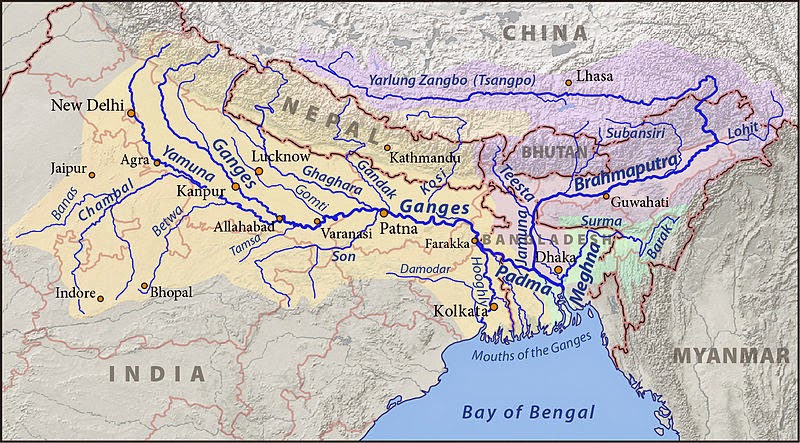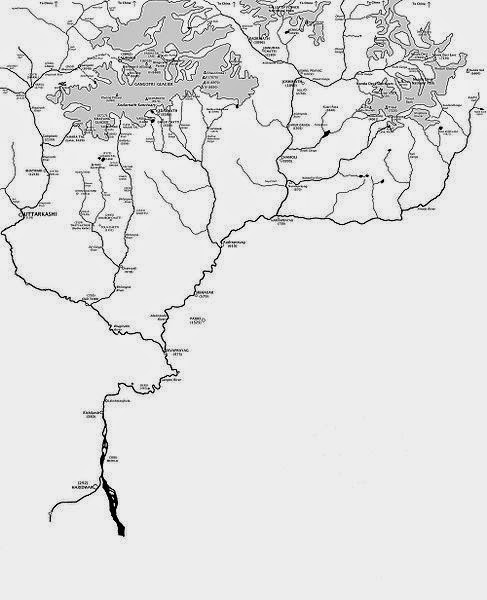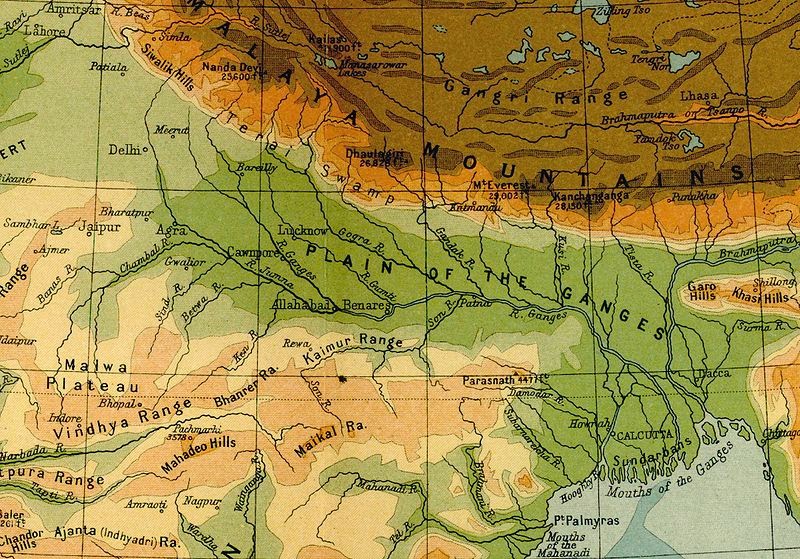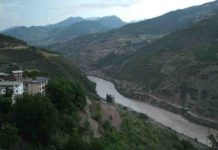
The Ganges, also Ganga is a trans-boundary river of Asia which flows through India and Bangladesh. The 2,525 km (1,569 mi) river rises in the western Himalayas in the Indian state of Uttarakhand, and flows south and east through the Gangetic Plain of North India into Bangladesh, where it empties into the Bay of Bengal. It is the third largest river by discharge.
The Ganges is the most sacred river to Hindus. It is also a lifeline to millions of Indians who live along its course and depend on it for their daily needs. It is worshipped as the goddess Ganga in Hinduism. It has also been important historically, with many former provincial or imperial capitals (such as Pataliputra, Kannauj, Kara, Kashi, Allahabad, Murshidabad, Munger, Baharampur, Kampilya, and Kolkata) located on its banks.
The Ganges was ranked as the fifth most polluted river of the world in 2007. Pollution threatens not only humans, but also more than 140 fish species, 90 amphibian species and the endangered Ganges river dolphin. The Ganga Action Plan, an environmental initiative to clean up the river, has been a major failure thus far, due to corruption, lack of technical expertise, poor environmental planning, and lack of support from religious authorities.
Course
The Ganges begins at the confluence of the Bhagirathi and Alaknanda rivers at Devprayag. The Bhagirathi is considered to be the true source in Hindu culture and mythology, although the Alaknanda is longer The headwaters of the Alakananda are formed by snowmelt from such peaks as Nanda Devi, Trisul, and Kamet. The Bhagirathi rises at the foot of Gangotri Glacier, at Gaumukh, at an elevation of 3,892 m (12,769 ft).

Although many small streams comprise the headwaters of the Ganges, the six longest and their five confluences are considered sacred. The six headstreams are the Alaknanda, Dhauliganga, Nandakini, Pindar, Mandakini, and Bhagirathi rivers. The five confluences, known as the Panch Prayag, are all along the Alaknanda. They are, in downstream order: Vishnuprayag, where the Dhauliganga joins the Alaknanda; Nandprayag, where the Nandakini joins; Karnaprayag, where the Pindar joins; Rudraprayag, where the Mandakini joins; and, finally, Devprayag, where the Bhagirathi joins the Alaknanda to form the Ganges River proper.
After flowing 250 kilometres (160 mi) through its narrow Himalayan valley, the Ganges emerges from the mountains at Rishikesh, then debouches onto the Gangetic Plain at the pilgrimage town of Haridwar. At Haridwar, a dam diverts some of its waters into the Ganges Canal, which irrigates the Doab region of Uttar Pradesh, whereas the river, whose course has been roughly southwest until this point, now begins to flow southeast through the plains of northern India.
The Ganges follows an 800-kilometre (500 mi) arching course passing through the cities of Kannauj, Farukhabad, and Kanpur. Along the way it is joined by the Ramganga, which contributes an average annual flow of about 500 m3/s (18,000 cu ft/s). The Ganges joins the Yamuna at the Triveni Sangam at Allahabad, a holy confluence in Hinduism. At their confluence the Yamuna is larger than the Ganges, contributing about 2,950 m3/s (104,000 cu ft/s), or about 58.5% of the combined flow.
Now flowing east, the river meets the Tamsa River (also called Tons), which flows north from the Kaimur Range and contributes an average flow of about 190 m3/s (6,700 cu ft/s). After the Tamsa the Gomti River joins, flowing south from the Himalayas. The Gomti contributes an average annual flow of about 234 m3/s (8,300 cu ft/s). Then the Ghaghara River(Karnali River), also flowing south from the Himalayas of Nepal, joins. The Ghaghara(Karnali), with its average annual flow of about 2,990 m3/s (106,000 cu ft/s), is the largest tributary of the Ganges. After the Ghaghara(Karnali) confluence the Ganges is joined from the south by the Son River, contributing about 1,000 m3/s (35,000 cu ft/s). The Gandaki River, then the Kosi River, join from the north flowing from Nepal, contributing about 1,654 m3/s (58,400 cu ft/s) and 2,166 m3/s (76,500 cu ft/s), respectively. The Kosi is the third largest tributary of the Ganges, after the Ghaghara(Karnali) and Yamuna.
Along the way between Allahabad and Malda, West Bengal, the Ganges passes the towns of Chunar, Mirzapur, Varanasi, Ghazipur, Patna, Bhagalpur, Ballia, Buxar, Simaria, Sultanganj, and Saidpur. At Bhagalpur, the river begins to flow south-southeast and at Pakur, it begins its attrition with the branching away of its first distributary, the Bhāgirathi-Hooghly, which goes on to become the Hooghly River. Just before the border with Bangladesh the Farakka Barrage controls the flow of the Ganges, diverting some of the water into a feeder canal linked to the Hooghly for the purpose of keeping it relatively silt-free. The Hooghly River is formed by the confluence of the Bhagirathi River and Jalangi River at Nabadwip, and Hooghly has a number of tributaries of its own. The largest is the Damodar River, which is 541 km (336 mi) long, with a drainage basin of 25,820 km2 (9,970 sq mi). The Hooghly River empties into the Bay of Bengal near Sagar Island. Between Malda and the Bay of Bengal, the Hooghly river passes the towns and cities of Murshidabad, Nabadwip, Kolkata and Howrah.
After entering Bangladesh, the main branch of the Ganges is known as the Padma. The Padma is joined by the Jamuna River, the largest distributary of the Brahmaputra. Further downstream, the Padma joins the Meghna River, the second largest distributary of the Brahmaputra, and takes on the Meghna’s name as it enters the Meghna Estuary, which empties into the Bay of Bengal.
The Ganges Delta, formed mainly by the large, sediment-laden flows of the Ganges and Brahmaputra rivers, is the world’s largest delta, at about 59,000 km2 (23,000 sq mi). It stretches 322 km (200 mi) along the Bay of Bengal.
Only the Amazon and Congo rivers have a greater average discharge than the combined flow of the Ganges, the Brahmaputra, and the Surma-Meghna river system. In full flood only the Amazon is larger
Geology
The Indian subcontinent lies atop the Indian tectonic plate, a minor plate within the Indo-Australian Plate. Its defining geological processes commenced seventy-five million years ago, when, as a part of the southern supercontinent Gondwana, it began a northeastwards drift—lasting fifty million years—across the then unformed Indian Ocean. The subcontinent’s subsequent collision with the Eurasian Plate and subduction under it, gave rise to the Himalayas, the planet’s highest mountains. In the former seabed immediately south of the emerging Himalayas, plate movement created a vast trough, which, having gradually been filled with sediment borne by the Indus and its tributaries and the Ganges and its tributaries, now forms the Indo-Gangetic Plain.
The Indo-Gangetic Plain is geologically known as a foredeep or foreland basin.
Hydrology
The hydrology of the Ganges River is very complicated, especially in the Ganges Delta region. One result is different ways to determine the river’s length, its discharge, and the size of its drainage basin.
The name Ganges is used for the river between the confluence of the Bhagirathi and Alaknanda rivers, in the Himalayas, and the India-Bangladesh border, near the Farakka Barrage and the first bifurcation of the river. The length of the Ganges is frequently said to be slightly over 2,500 km (1,600 mi) long, about 2,505 km (1,557 mi), to 2,525 km (1,569 mi), or perhaps 2,550 km (1,580 mi). In these cases the river’s source is usually assumed to be the source of the Bhagirathi River, Gangotri Glacier at Gomukh, and its mouth being the mouth of the Meghna River on the Bay of Bengal. Sometimes the source of the Ganges is considered to be at Haridwar, where its Himalayan headwater streams debouch onto the Gangetic Plain.
In some cases, the length of the Ganges is given for its Hooghly River distributary, which is longer than its main outlet via the Meghna River, resulting in a total length of about 2,620 km (1,630 mi), from the source of the Bhagirathi, or 2,135 km (1,327 mi), from Haridwar to the Hooghly’s mouth. In other cases the length is said to be about 2,240 km (1,390 mi), from the source of the Bhagirathi to the Bangladesh border, where its name changes to Padma.

The Tons-Yamuna-Ganga continuous flow is the longest river in the Ganges basin. However, by convention, Tons is considered as a separate river, and the length of Ganga and Yamuna is calculated from Gangotri and Yamunotri respectively. If calculated from source of Tons, the length of Tons-Yamuna-Ganga river is 2,758 km.
For similar reasons, sources differ over the size of the river’s drainage basin. The basin covers parts of four countries, India, Nepal, China, and Bangladesh; eleven Indian states, Himachal Pradesh, Uttarakhand, Uttar Pradesh, Madhya Pradesh, Chhattisgarh, Bihar, Jharkhand, Punjab, Haryana, Rajasthan, West Bengal, and the Union Territory of Delhi. The Ganges basin, including the delta but not the Brahmaputra or Meghna basins, is about 1,080,000 km2 (420,000 sq mi), of which 861,000 km2 (332,000 sq mi) are in India (about 80%), 140,000 km2 (54,000 sq mi) in Nepal (13%), 46,000 km2 (18,000 sq mi) in Bangladesh (4%), and 33,000 km2 (13,000 sq mi) in China (3%). Sometimes the Ganges and Brahmaputra–Meghna drainage basins are combined for a total of about 1,600,000 km2 (620,000 sq mi), or 1,621,000 km2 (626,000 sq mi). The combined Ganges-Brahmaputra-Meghna basin (abbreviated GBM or GMB) drainage basin is spread across Bangladesh, Bhutan, India, Nepal, and China.
The Ganges basin ranges from the Himalaya and the Transhimalaya in the north, to the northern slopes of the Vindhya range in the south, from the eastern slopes of the Aravalli in the west to the Chota Nagpur plateau and the Sunderbans delta in the east. A significant portion of the discharge from the Ganges comes from the Himalayan mountain system. Within the Himalaya, the Ganges basin spreads almost 1,200 km from the Yamuna-Satluj divide along the Simla ridge forming the boundary with the Indus basin in the west to the Singalila Ridge along the Nepal-Sikkim border forming the boundary with the Brahmaputra basin in the east. This section of the Himalaya contains 9 of the 14 highest peaks in the world over 8,000m in height, including Mount Everest which is the high point of the Ganges basin. The other peaks over 8,000m in the basin are Kangchenjunga, Lhotse, Makalu, Cho Oyu, Dhaulagiri, Manaslu, Annapurna and Shishapangma. The Himalayan portion of the basin includes the south-eastern portion of the state of Himachal Pradesh, the entire state of Uttarakhand, the entire country of Nepal and the extreme north-western portion of the state of West Bengal.
The discharge of the Ganges also differs by source. Frequently, discharge is described for the mouth of the Meghna River, thus combining the Ganges with the Brahmaputra and Meghna. This results in a total average annual discharge of about 38,000 m3/s (1,300,000 cu ft/s), or 42,470 m3/s (1,500,000 cu ft/s). In other cases the average annual discharges of the Ganges, Brahmaputra, and Meghna are given separately, at about 16,650 m3/s (588,000 cu ft/s) for the Ganges, about 19,820 m3/s (700,000 cu ft/s) for the Brahmaputra, and about 5,100 m3/s (180,000 cu ft/s) for the Meghna.
The maximum peak discharge of the Ganges, as recorded at Hardinge Bridge in Bangladesh, exceeded 70,000 m3/s (2,500,000 cu ft/s). The minimum recorded at the same place was about 180 m3/s (6,400 cu ft/s), in 1997.
The hydrologic cycle in the Ganges basin is governed by the Southwest Monsoon. About 84% of the total rainfall occurs in the monsoon from June to September. Consequently, streamflow in the Ganges is highly seasonal. The average dry season to monsoon discharge ratio is about 1:6, as measured at Hardinge Bridge. This strong seasonal variation underlies many problems of land and water resource development in the region. The seasonality of flow is so acute it can cause both drought and floods. Bangladesh, in particular, frequently experiences drought during the dry season and regularly suffers extreme floods during the monsoon.
In the Ganges Delta many large rivers come together, both merging and bifurcating in a complicated network of channels. The two largest rivers, the Ganges and Brahmaputra, both split into distributary channels, the largest of which merge with other large rivers before themselves joining. This current channel pattern was not always the case. Over time the rivers in Ganges Delta have changed course, sometimes altering the network of channels in significant ways.
Before the late 12th century the Bhagirathi-Hooghly distributary was the main channel of the Ganges and the Padma was only a minor spill-channel. The main flow of the river reached the sea not via the modern Hooghly River but rather by the Adi Ganga. Between the 12th and 16th centuries the Bhagirathi-Hooghly and Padma channels were more or less equally significant. After the 16th century the Padma grew to become the main channel of the Ganges. It is thought that the Bhagirathi-Hooghly became increasingly choked with silt, causing the main flow of the Ganges to shift to the southeast and the Padma River. By the end of the 18th century the Padma had become the main distributary of the Ganges. One result of this shift to the Padma was that the Ganges joined the Meghna and Brahmaputra rivers before emptying into the Bay of Bengal, together instead of separately. The present confluence of the Ganges and Meghna formed about 150 years ago.
Near the end of the 18th century, the course of the lower Brahmaputra changed dramatically, altering its relationship with the Ganges. In 1787 there was a great flood on the Teesta River, which at the time was a tributary of the Ganges-Padma River. The flood of 1787 caused the Teesta to undergo a sudden change course (an avulsion), shifting east to join the Brahmaputra and causing the Brahmaputra to shift its course south, cutting a new channel. This new main channel of the Brahmaputra is called the Jamuna River. It flows south to join the Ganges-Padma. Since ancient times the main flow of the Brahmaputra was more easterly, passing by the city of Mymensingh and joining the Meghna River. Today this channel is a small distributary but retains the name Brahmaputra, sometimes Old Brahmaputra. The site of the old Brahmaputra-Meghna confluence, in the locality of Langalbandh, is still considered sacred by Hindus. Near the confluence is a major early historic site called Wari-Bateshwar.
Note : The above story is based on materials provided by Wikipedia.










